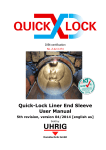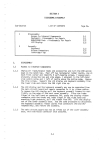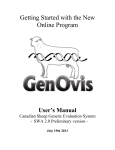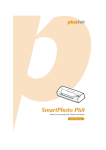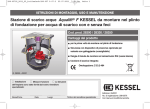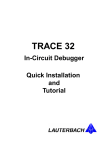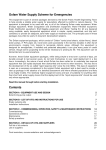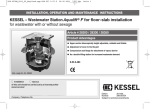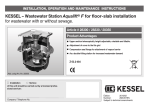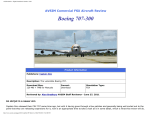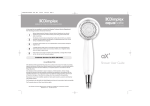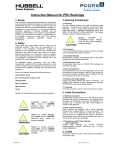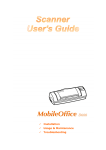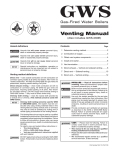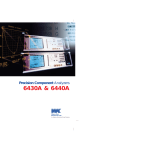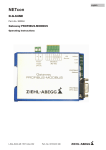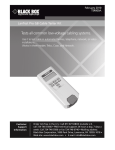Download Operators Manual Revision 2 from 04.12.2009
Transcript
WRC Approval. Nr. UC7982 DIBt Approval Nr. Z-42.3-374 Operators Manual Revision 2 from 04.12.2009 Sales and Distribution: Kanaltechnik GmbH List of Contents 1. System description 1.1 Definition 2.2 System description and Installation Procedures 1.3 Materials 1.3.1 Stainless steel 1.3.2 EPDM-rubber 1.4 Range of applications 1.4.1 Trouble shooting and failure modes 2. Using Quick-Lock 2.1 Inspection and preparation of the damaged Pipe section 2.1.1 Inspection 2.1.2 Preparation of the damaged Pipe section 2.2 Equipment, material and preparation for the Quick-Lock Installation 2.2.1 Equipment 2.2.2 Material 2.2.3 New! Quick-Lock sleeves with End crimping 2.2.4 Preparation of the Quick-Lock sleeve 2.3 Quick-Lock Installation 2.3.1 Positioning of the Quick-Lock sleeve 2.3.2 Procedure for single Installations 2.3.3 Procedure for Serial Installation 2.3.3 Serial installation with non crimped sleeves- version 1 2.3.3 Serial installation with crimped sleeves- version 2 2.3.4 Installation using laser positioning 2.3.5 Quick-Lock sleeve for joint displacement 2.3.6 Ground water infiltration 2.3.7 Root Infiltration 2.3.8 Concrete pipes with exposed reinforcement 2.3.9 Rehabilitation of plastic pipes 2.3.10 Quick-Lock in sealed pipe systems 2.3.11 Removal of Installed Quick-Lock sleeves 2.3.12 Air Cushion Release by means of Fast venting Technical data sheet for Quick-Lock Table of Installation pressures (compression pressures) Product recommendations 3 3 3 4 4 4 4 4 5 5 5 5 6 6 6 6 7 8 8 9 11 12 13 14 15 16 17 17 18 18 19 19 Annex 1 Annex 2 Annex 3 1 Stand: 04.12.2009 Foreword Dear Quick Lock user, We have produced this Manual with the intention of providing you with all the necessary information and operating instructions for installation of the Quick Lock Local Patch repair system. It contains pictures, diagrams and information that is based on extensive testing and field experience, collected over the 10 years of daily use by our long term installation partners. Quick Lock is one of the most user-friendly Local Patch repair systems. Still, the installer is required to have fundamental knowledge in sewer construction and background experience gained in sewer renovation. This user manual cannot replace the individual “hands on experience” gained by the installer, but it does provide helpful tips and hints that will facilitate your work with the Quick Lock system. Uhrig as manufacturer provides schooling and practical training for their installation partners. We would appreciate any feedback concerning your experience made with the Quick Lock system during installation. Together we can so develop and advance the Quick Lock technology. Should you have any queries or require further information, please contact us. Geisingen, December 2009. Uhrig Kanaltechnik GmbH Am Roten Kreuz 2 D-78187 Geisingen Germany Mark Biesalski Division Manager Telefon +49 (0) 7704 / 806-33 Fax +49 (0) 7704 / 806-50 e-mail [email protected] 2 Stand: 04.12.2009 1. System description Quick-Lock 1.1 Definition Quick-Lock is a local patch Sleeve made of made of V4A stainless steel and an EPDM compression seal. The system uses a purely mechanical locking system. It is very variable, adapting to all pipe sizes from DN 150 to DN 700 and can be extended almost limitlessly in length. fig. 1.1-(1): Quick-Lock. The Quick-Lock system can be used for all normal Sewer networks, fountain and drinking water pipe systems. 1.2 System description and Installation procedure Quick-Lock consists of a rolled V4A Stainless steel sleeve covered with an EPDM rubber seal. The repair and seal of the damaged areas in the pipe network is achieved by means of permanent pressure contact of the EPDM rubber seal to the pipe, wall held in place through the expanded stainless steel sleeve. fig. 1.2-(1): compression principle The stainless steel sleeve compressed / rolled is approx. 40 mm smaller than the nominal diameter of the pipe to be rehabilitated. Two parallel toothed “rails” have been stance into the sleeve. In each toothed rail is a lock and gear mechanism, which guides the sleeve plate when expanding. Upon reaching the end position and pressure contact at the pipe wall has been achieved, the gear mechanism locks the sleeve permanently in place. During the expanding procedure the „click“ sound of the gear fig 1.2 (2): rolled-up stainless steel sleeve with wheels in the locking Mechanism is apparent. toothed strips and locking mechanism The distance between tooth notch and tooth head is one click. This means that the max. possible reduction after expansion is the return of a tooth head to the next lower groove a which is approx. 0,65 mm in diameter depending on the nominal width of pipe. The geared locking mechanism moves in a constant fluid motion. Distance from gear wheel top to gear wheel top: 4 mm Direction of rotation During expansion process Tooth Strip direction of rotation during expansion Gear wheel Crown Gear wheel groove Tooth Strip Stand: 04.12.2009 Return stop (locking function by means of the middle gear wheel) 3 1.3 Materials 1.3.1 Stainless steel The Quick-Lock sleeve is made of V4A stainless steel, grade 1.4404. Stainless steel in this quality is characterised by its high resistance to corrosion. Quick-Lock is designed for the use in municipal sewage networks. Before using Quick lock in industrial sewage networks the affluent in the network should be analysed and the corrosion resistance of the stainless steel checked. 1.3.2 EPDM-rubber The thermoplastic EPDM rubber seal has also been designed for use in municipal sewage. EPDM has excellent physical characteristics and resistance to deterioration, ozone, atmospheric and environmental influences, alkali and different base chemicals. Under certain circumstances the EPDM rubber can react with some substances: • solvents • ether, ester, keton, methyl chloride • animal and vegetable fats, oils, fuels • concentrated fruit juices, oxidizing acids Note: Before using Quick-Lock in industrial, non municipal sewage networks, the concentration and resistance of the V4A stainless steel and EPDM rubber must be checked! 1.4 Range of applications 1.4.1 Forms of Common damage in Sewer pipe networks • Cracking (longitudinal, radial and traverse cracks) • Shard formation • Infiltration and leaking Joints • Settling sagging / Joint displacement • Closing / sealing dormant unused laterals • Corrosion / flaking / wear (Reinforced concrete pipes with exposed steel) • Ground water Infiltration (Silt build up) • Weakened pipe static (Cracks and shard formation, pipe deformation) • Root infiltration (Reduction of pipe diameter) 4 Stand: 04.12.2009 2. Quick-Lock Installation 2.1 Inspection and preparation of the damaged section. 2.1.1 Inspection • Before installation of the Quick-Lock Local Patch system, the damaged Pipe section should be inspected and the accessibility for the Quick-Lock installation Trolley checked. • At least one possible access through a manhole or revision opening is required for installation. • The sewer manhole should have at least a nominal width of DN 800, to allow the camera and installations system to be fed into the pipe. The sewer channel must also have sufficient room to move the installations trolley with sleeve into position. 2.1.2 Preparation of the damaged section • All Pipe Sections must be cleaned through high pressure jetting before every Quick-Lock installation. • Hardened deposits, root infiltration, protruding pipe connections must all be mechanically removed by means of appropriate milling tools. There should be no obstacles hindering access to the damaged pipe section. Example for the space required, allowing installations trolley + sleeve into the damaged section: Pipe Centre Trolley centre Note: The original installation trolleys run with their centres approx. 0,5 cm under the pipe centre. Example of Required Space calculation: Ø Pipe : Ø Q.L. rolled, incl. EPDM rubber : 300 mm 263 mm (see technical data sheet) 300 mm – 263 mm = 37mm top and bottom in total Top: 37 mm / 2 = 18.5 mm + 5 mm (Centre is offset pipe / packer) = 23.5 mm Bottom: 37 mm / 2 = 18.5 mm – 5 mm (Centre is offset pipe / packer) = 13.5 mm • There should be no solid matter such as sand or gravel in the damaged sections. • Joint displacements of more than 1,5 cm need to be milled before installing single sleeves or two Quick-Lock sleeves in serial. [see chapter 2.3.4]. • Normally Quick Lock can be installed in live or running sewer operations. The back build up height should not amount more than approx. 20 % of the sewer cross section. If too many solid parts are washed in during sewer operations, the damaged section will need to be closed off with bungs or packers. In this case over pumping or tankering is advisable. 5 Stand: 04.12.2009 2.2 Equipment, material and preparations for the Quick-Lock installation. 2.2.1 Equipment The following Equipment is required for the economic Quick-Lock installation: • Standard sewer camera (CCTV), matching the pipe diameter of the damaged section. Ideally the camera should have pivoting and zoom functions. • Quick-Lock installation trolley acc. to pipe dia • Quick-Lock connecting rod for connecting camera and trolley • Quick release valve [see 2.3.12] • Standard compressed air system onboard vehicle or Compressor with an output of at least 5,0 bar. • At least 100 m. of compressed air hose on a reel. • A suitable milling robot for job preparation. 2.2.2 Material Depending on the form of pipe damage, the following materials are necessary for preparation of the Quick-Lock sleeve installation; fig.. 2.2.1 (1): equipment • Sharp knife • Talcum powder • Superglue • Biodegradable contact spray or food lubricant • Swelling rubber (ground water infiltration) • Mineral Flex-adhesive (root infiltration, corrosion reinforced concrete pipes) 2.2.3 New! Quick-Lock sleeves with Crimped End One end of the sleeve has been mechanically widened to form a “lip” closing the distance between the wall of the existing pipe network and the Quick Lock Sleeve. The reason for this new development is to ensure a smoother water flow and a higher mechanical resistance to jetting nozzles during high pressure cleaning of the pipe network. This also ensures a tighter seal at the sleeve end to the wall of the existing pipe. The crimping size is between 3 to 5 mm in respect to the standard width and dimensions of the non compressible EDPM rubber Sealing Gasket used. The crimped end closes the gap between the Quick Lock Sleeve and the existing Pipe wall, but does not exert any pressure on the walls of the damaged existing pipe. fig. 2.2.3 (1): sleeve without crimping fig. 2.2.3 (2) sleeve with crimping This technical modification affects the old installation procedure. 6 Stand: 04.12.2009 The correct procedure is described in the following pages. 2.2.4 Preparation of the Quick-Lock sleeve a) Transportation Strip The white adhesive strip with the Quick Lock Logo attached to the sleeve joint overlap, prevents any movement during transport. Before installation, cut half of the adhesive strip in the area of the sleeve overlap. If the adhesive strip is cut completely through, the risk is that the sleeve can start to expand prematurely during transport into position in the damaged pipe. If the sleeve expands prematurely then this will hinder movement through the pipe section. If the adhesive strip is not cut halfway through, the risk is that the Sleeve expands too abruptly after snapping the adhesive strip fig. 2.2.4 (1): cut adhesive strip only halfway through during the expansion procedure, and the geared locking mechanism can be damaged or destroyed. b) Fitting the EPDM rubber • For better handling sprinkled inside the EPDM rubber with talcum powder. This enables the EPDM rubber to be slipped more easily over the stainless steel sleeve and friction between rubber and sleeve are reduced during the expansions process. • With the Sleeve on its end, Slip the EPDM rubber over the sleeve so that the rubber overlap for serial installation is at the top. New! For fitting the EDPM rubber on the crimped sleeve, make sure that the crimped end of the sleeve is at the bottom (Sleeve standing upright the crimped end on the ground) And the rubber pushed over the uncrimped end. As normal Photo. 2.2.4 (2): Sprinkle Talc inside the rubber overlap for serial installation is at the top. The opposite rubber edge should sit behind the start of the crimping. EPDM rubber • The rubber overlap is cut off for single Quick Lock installations. Check first that the distance between the sealing profiles is sufficient to cover the length of the damaged section. If the distance is not sufficient then a serial installation is required to seal the damaged pipe section. In this case the rubber overlap should not be cut off. • For single installations the EPDM rubber is to be cut and set on the sleeve so that the rubber edge is approx. 3 mm behind the edge of the stainless steel sleeve. [photo.2.2.4 (5)] c) Fixing EPDM rubber approx 3 mm Photo 2.2.4 (3):slip EPDM rubber over Stand: 04.12.2009 Photo 2.2.3 (5): distance of EPDM rubber from sleeve edge Photo2.2.4 (4): EPDM rubber. Cut overlap 7 • To avoid movement of the EPDM rubber seal on the stainless steel sleeve during the transport to the damaged pipe section, fix the rubber to the stainless steel sleeve above the lock positions on both sides and opposite ends with a dot of superglue. • The superglue should in no way be allowed into the plate overlap, otherwise due to the superglue adhesion, the expansion of the sleeve is no longer possible. • If the EPDM rubber is not fixed, there is the possibility that it can slide off during transport and before reaching the damaged pipe section. fig.2.2.4 (6): fix EPDM rubber fig.2.2.4 (7): fix EPDM rubber d) Spray toothed rail and locks with a lubricant spray • During the Quick-Lock expansions process friction can occur in the Sleeve overlap. To enable a smooth and constant running of the toothed rails and gear wheels spray the area lightly with a biodegradable lubricant spray. To avoid any complications during installation, take care that the lubricant spray does not come into contact with the inside or outside of the EPDM rubber seal. fig. 2.2.4 (8): spraying of the toothed rail 2.3 Quick-Lock installation 2.3.1 Positioning of the Quick-Lock sleeve on the installations trolley Middle of toothedtrail at 12. o’clock position • The Quick-Lock sleeve is positioned on the installations trolley so that the middle of the tooth rail is seated at the 12.00 o’clock position. The lock, depending then on line of sight, is seated then in the 11.00 or 01.00 position. During the installation process the lock “wanders” and sits after completing the installation process in the 12.00 o’clock position [fig.2.3.1 (1)]. fig. 2.3.1 (1): position of the locks Stand: 04.12.2009 8 • Due to the reduced space with serial installations and also depending on the type of camera and attachment method of the connection rod, it may be necessary to position the sleeve on the installations trolley with the lock in the 12.00 o’clock position. This is to avoid any snagging of the installations trolley when passing through a pipe section where a Quick Lock has already been installed. This can also apply if during serial installation the view of the expanding lock is hindered by a sleeve lock that has already been installed. After the installation the locks should then sit, depending on the direction of viewing, in the 11.00 or 01.00 o’clock position. end of toothedtrail fig.. 2.3.1 (2): wheel sets • During preparation for installation one should be accustomed to setting the sleeve on the installations trolley with tooth rails always facing in the same direction. This ensures a regular lock alignment with serial installation. • Select the correct wheel set for the Pipe diameter where the Quick Lock is to be installed. Position the Q.L. sleeve as far to the front of the trolley so that one has good visibility of the edge of the sleeve through the CCTV camera. • The positioning of the sleeve on the trolley should normally be carried out in the sewer pipe. fig.. 2.3.1 (3): Pos. on the Installation trolley 2.3.2 Installation procedure for single Sleeves It is more economical to use the camera robot to position the installations trolley. The process can also be carried out with rods or other means, but the camera is required to observe the correct positioning of the trolley and installation in the damaged area. • If there is lack of space but 2 manholes are available, it can be advisable to feed the camera in from one manhole drive through and collect the sleeve in the second manhole. fig. 2.3.2 (1): connection camera-Installations trolley • Connect the camera to the installations trolley with the coupling rod, connect the compressed air supply and lightly inflate the cushion of the installations trolley to secure the sleeve on the trolley with a pressure of approx. 0,5 bar. The sleeve is now secured from slipping off the trolley. The attachment pressure of approx. 0,5 bar can vary depending on the compressed air system, nominal width and the installations trolley used. 9 Stand: 04.12.2009 We recommend that you first test and determine the correct pressure for your own system. fig. 2.3.2(2): inflate cushion lightly and secure sleeve in position • Position the Trolley with the Quick-Lock sleeve in the centre of the damaged area. New! When installing crimped sleeves the crimped side must always be set against direction of flow [fig. 2.3.2 (2)]. • The correct position can be either calculated from previous calibration of the damaged area or live viewing through the CCTV camera. The distance from camera head to sleeve centre must also be taken into account. • Attach the Quick-Lock sleeve with a pressure of approx. 1,5 bar to 2,0 bar to the damaged pipe wall. Make sure that the sleeve is at first only „lightly“expanded against the pipe wall. This allows a possible position correction should this be necessary. Deflate the cushion slightly and release the trolley, so that it can move forward and recentre again in the middle of the QL sleeve. • If the sleeve position is correct, the installation pressure of 2,5-3,5 bar is then applied.[See Diagram. 2] (Depending on damage and type of pipe) Repeat the procedure once again. Make sure that the trolley cushion is positioned in the centre of the sleeve and then apply the installation pressure. The necessary installation pressure and compression of the EPDM seal rubber has then been carried out. Note: Where the pipe damage is in the form of longitudinal cracks or shard formations, mainly in vitrified clay pipes, do not over expand the sleeve after the locking and sealing of the damaged area has been achieved, otherwise the existing pipe could be further damaged. Torsion forces can damage the lock or the tooth rails if the sleeve is eccentrically expanded (out of centre) fig. 2.3.2 (3) positioning and installation pressure Stand: 04.12.2009 10 • Check the correct position of the sleeve with the camera. For this purpose, pivot the camera lens along the edges of the sleeve. This should show that the sleeve is now pressed equally against the pipe wall. [Photo.2.3.2 (4)]. • During installation or repositioning it can occur that one end of the sleeve needs to be retightened. • In glazed vitrified clay pipes the camera spotlights can cause a reflection of the sleeve edge on the pipe wall. [Photo. 2.3.2 (5)]. The client could misinterpret this as a gap and believe that the sleeve is not sitting correctly. This optical illusion disappears after pivoting and changing the camera angle. Reflections on pipe wall Dia. 2.3.2 (4): Installed sleeve compressed against the pipe wall dia. 2.3.2 (5): reflections 2.3.3 Procedure for serial installation The serial installation should be used when the damaged section is longer than the distance between the two sets of double rings on the EDPM rubber. Cut the rubber overlap only from the last sleeve to be installed. The installation process and the installation pressures are the same for single and serial installation. Distance between sealing rings • Slide the EPDM rubber over the stainless steel sleeve so that the distance between the sealing rings and sleeve edge is the same or larger than the distance between lock and sleeve edge. Only then can a seal within the rubber overlap be certain. • Always make certain that the seal rings under the rubber overlap are not sitting too close to the sleeve edge. and sleeve edge Distance between the lock and sleeve egde • The EPDM rubber can also be shortened by approx. 1,5 cm This means that the rubber strip between sealing rings and sleeve edge is cut, in order to reduce the thickness of the offset in the sleeve overlap. fig. 2.3.3. (1): distances • The first sleeve is installed with at least one set of ring seals in an intact pipe area • Ideally the installation should always be carried out against the direction of flow. The small offset in the area of overlap should cause no obstruction for the pipe flow. New! Quick Lock with crimped and non crimped ends can be used together for serial installation. The leading sleeve against direction of flow should always be a crimped sleeve. We strongly recommend that the installation be carried out according to the Diagram as in version 1 shown. 11 Stand: 04.12.2009 Version 1: Installing non crimped sleeves against direction of flow fig. 2.3.3 (2): Install QL sleeve without crimping first the second sleeve slots inside, metal overlapping • The area between lock and sleeve edge of the first sleeve can be fully used for setting the following sleeves. In no case set the following sleeve on the lock of the first sleeve. When possible use the laser for guiding as described in the following chapter. fig. 2.3.3 (3): photo Sleeve overlaps Sleeve in Sleeve fig. 2.3.3.(4): photo A finished serial installation. All locks in row dia. 2.3.3 (5): serial installation in sleeve without crimping last sleeve installed with crimping 12 Stand: 04.12.2009 • The rubber overlap of the last sleeve to be set is cut; the crimping is aligned against the direction of flow. Version 2: Installation of crimped sleeves in direction of flow Disadvantages: The Pipe cross section is reduced in size The overlapping against the direction of flow forms a “stepping” which disturbs the flow and natural hydraulics Installed sleeves and smaller cross sections are less accessible for machines fig 2.3.3 (7): Sleeve in Sleeve serial Installation with Sleeve crimping. In diagram 2.3.3(7), the Pipe cross Section is reduced by approx. 2 to 4 mm, compared to diagram 2.3.3(5), and is caused by the crimped ends installed inside another sleeve. In small pipe dimensions and where existing pipes are deformed, the installed sleeves not only reduce the pipe diameter but make it also more difficult to access or drive through with the installation trolley and additional sleeves. If it is necessary to install further sleeves in the same pipe network, it is advisable to carry out the installation from an alternative second manhole or access point. Drive the installations trolley, with sleeve, through the rubber overlap of the last sleeve that was installed, by a full sleeve length. In doing so the rubber overlap of the already installed Sleeve folds inwards over the Trolley that is passing through. Now the sleeve is positioned in flow direction, whereby the rubber overlap of the last Sleeve springs forward folding out again to the normal position, the installations trolley can then be moved into the correct position and the sleeve installed. 13 Stand: 04.12.2009 2.3.4 Working with the laser positioning marker The Quick Lock Sleeves can be installed much faster and accurately using the laser positions marker, which is installed on the end of installations trolley. Here we explain two methods for serial installation „sleeve in sleeve“: Method 1 • The laser position marker is mounted on the front end of the installations trolley, either next to the air connector [fig. 2.3.4 (1)] or seated directly above. The laser must not protrude over the top of the end plate. If there is there is no predrilled and threaded hole in the end plate of the installations trolley for fitting the laser head, then drill a hole into the front end plate and tap thread for max M4 and a max. depth of 13 mm. • The Quick-Lock sleeve is positioned on the trolley so that the laser beam and sleeve edge are both visible when in the pipe to be rehabilitated. • The installations trolley and sleeve are positioned in the sewer so that the laser beam shines on the back lock edge of the sleeve already installed. [fig. 2.3.4 (1)].Ca. 0,5 – • After the installations process the sleeve edge should Sit approx. 0,5 – 1,0 cm behind the lock of the already installed sleeve [fig. 2.3.4 (2)]. Note: With this method the installations trolley is not sitting in the middle of the sleeve during expansion. Before installation, grease the overlapping area of the stainless steel faces of the Quick Lock sleeve to avoid the sleeve expanding eccentrically. fig. 2.3.4(1): Positioning of the Sleeve with laser aid fig. 2.3.4 (2): Distance of sleeve end to lock Method 2 For the second method the installation is carried out using distance measurement. • Position the sleeve in the centre of the installations trolley. Measure the distance between sleeve end and laser. Use the same distance measurement when positioning the other sleeves to be installed. (Tip:) Mark the position on the trolley top and inside of all the Sleeves with a marker to so that the laser beam can be matched into position in the pipe system and the following sleeve edges always sit in the same position. Always make sure that the sleeves are facing in the same/ right direction. The installation can then begin. Transfer difference Difference Installations trolley !!Always follow the safety instructions for „target lasers“!! 14 Stand: 04.12.2009 2.3.5 Installing Quick-Lock at displaced joints Displaced or offset joints with openings up to 1, 5 cm can be rehabilitated with a single Quick-Lock sleeve. If the joint offset exceeds 1,5 cm then they should be milled. The offset can also be overcome by installing 2 Quick-Lock sleeves in serial installation. The installations process with two sleeves is the same process as used in serial Installations. [Diagram 2.3.5.], The only difference is in installing the first Sleeve. fig. 2.3.5 (1): joint seating repair • The first Quick-Lock sleeve is placed approx. 30 cm in the offset joint. The rubber overlap is not cut off. • The second Quick-Lock sleeve is installed with approx. 1,5 cm, of the Quick Lock Sleeve [Diagram 2.3.5.] inserted into the first sleeve. The double sealing rings grip inside the rubber overlap of the first sleeve installed creating a seal. So jointing, the two sleeves form a flexible area that compensates for any slight movement or uneven levels in the pipe joint. fig. 2.3.5 (2): detail Joint seating with Quick Lock 15 Stand: 04.12.2009 2.3.6 Ground water infiltration When installing Quick Lock in pipes where the pipe inner surface structure is extremely rough, strongly corroded surfaces, or there is evidence of a strong ground water infiltration, we recommend that the blue swelling rubber strip is used to insure that a seal is always achieved. This is attached over the EDPM rubber seal. We have found from experience that the use of the swelling rubber is indispensable when working with such worn and damaged pipes. • The blue rubber strip is fitted as described in following diagrams. The swelling rubber strip is fitted between the double sealing rings of the EDPM rubber. • Cut the required length from the roll. The length should fit snugly around the sleeve and EDPM rubber after jointing. • Joint the ends of the swell rubber with a dot of superglue. • Slip the swell rubber over the double sealing ring of the EDPM rubber. Make sure that swell rubber ring fits tightly around the EDPM rubber. fig. 2.3.6 (1): Cut the Swelling Rubber to the correct length fig. 2.3.6 (2): join the ends of the swelling rubber with super glue i g . 2 . 3 . 6 fig. 2.3.6 (3): Finished Sleeve with Swell rubber fitted ( 1 ) : s h o r t e n t h e Stand: 04.12.2009 e x p a n s i v e r u 16 2.3.7 Root infiltration Follow the special procedure to stop the root growth finding a way through and along the length of the quick lock seal and to avoid reclamation or repeat installations when installing Quick Lock in pipe networks with root infiltration. We find that even after extensive long term trials, that continued root growth cannot be totally excluded. • All root infiltration must be mechanically removed before rehabilitation can begin. • The area between the double sealing rings of the EPDM rubber seal is coated with high alkaline, mineral Flex adhesive The coating thickness should be to the top of the sealing rings [photo: 2.3.7 (1)]. • To avoid loss of coating in the pipe during movement to the damaged pipe section, it is important to use a product with adhesive qualities. The Flexible qualities ensure that the coating does not tear and can expand with the EDPM rubber during installation. [photo. 2.3.7 (2) and photo.2.3.7 (3)]. fig. 2.3.7 (1): Sleeve with coating fig. 2.3.7 (2): The coatings flexible qualities fig. 2.3.7 (3): The coating stretched 2.3.8 Surface erosion of Reinforced concrete pipes. The procedure described under [2.3.7 root infiltration] can also be used for concrete pipes with exposed reinforcing steel. The coating with high alkaline content forms a protective environment around the exposed steel reinforcing. The alkaline content found in concrete is the normal corrosion protection for the steel reinforcing. • Exposed or protruding steel reinforcing must be removed before rehabilitation. fig. 2.3.8 (1): Exposed protruding steel reinforcing fig 2.3.8 (2): after rehabilitation 17 Stand: 04.12.2009 2.3.9 Rehabilitation of plastic pipes The same Quick-Lock installations procedure can be used to rehabilitate Plastic pipes in single or serial installation. The following points should be taken into account before installation: • The stated diameter of a plastic pipe often refers to outer diameter. The stated size e.g. DN 250 does not mean that it has an inside diameter of 250 mm. •It is common to find that plastic pipes with deformations, can limit the access for robots and trolleys through the pipe network. If the Quick-Lock sleeve can still be installed at the damaged section with the trolley in spite of the deformations, then the sleeve adapts automatically to the deformation and increases the pipe strength statically stabilising the area again. •If you are unsure that a certain pipe size can be rehabilitated with Quick-Lock, please feel free to contact us. Our technical department can cross check if a quick Lock Sleeve can be supplied for the pipe section concerned. An adapted set of wheels for the installations trolley can be supplied for the project and can be returned to us upon completion of the installation. • Round drainage pipes can also be rehabilitated with Quick Lock without the function being impaired. Quick lock can also be used to rehabilitate damaged vertical pipes. We would be happy to advise you with any project queries that you have. fig. 2.3.9 (1): drain pipe before repair fig. 2.3.9 (2): drain pipe after repair 18 Stand: 04.12.2009 2.3.10 Quick Lock in Sealed Pipe systems The Quick Lock sleeve sealing takes place by compression of the EPDM rubber. This method has achieved excellent sealing results. If Quick Lock is used in sealed pipe systems, it is possible that pressure can build up in the space between the EDPM double sealing rings and the old pipe. This occurs especially in pipe systems with smooth walls (pipe/hose) and a dense structure (e.g. plastic hoses, GRP pipes and glazed stoneware pipes) This enclosed cushion of air (Hoover effect) may influence the purge stability and safety. Figure 2.3.10 (1):Experimental Over pressure Setup If the high-pressure jet or nozzle has contact with the sleeve edge, it is possible that the Quick Lock sleeve may move, or the high-pressure water jet could penetrate the area between sleeve and old pipe, increasing the already existing pressure pocket. Trials have shown that the existing pressure pocket will, through diffusion, slowly dissipate. 2.3.11 Removal of Installed Quick-Lock sleeves Quick-Lock is often used to seal dormant or unused laterals. Many clients require only a temporary sealing. This means that Quick Lock sleeves used as a temporary seal, then need to be removed. The same applies in the case of a misplaced or dislocated Sleeve. The locking mechanism must be removed for this purpose. • To remove an installed Quick-Lock sleeve, a milling robot with a metal cutting disk is required. Depending on the type of milling robot used by your Company the mounting pin for the cutting disk may need to be specially made. Photo. 2.3.11 (1): milling robot with Steel cutting disk 19 Stand: 04.12.2009 • Two cuts are required to dismantle each locking mechanism. The locking gear wheel is destroyed with the first cut, set just behind the two centre rivets. 2nd cut With the second cut the centre rivets holding the gear wheels in place and in the toothed rails are removed [photo. 2.3.11 (2)]. 1st cut Rivets The cover plate should now fall away, the sleeve tension should release and unlock. • The Quick-Lock sleeve should contract due to the tension release and the EPDM rubber shrinking back. The stainless steel sleeve can then be picked up with the milling robot head in the centre of the sleeve and removed from the damaged pipe section. Photo 2.3.11 (2): Locking Mechanism with Cover plate 2.3.12 Faster venting of the installations cushion with an air release valve To vent the expansion cushion faster after installation, a quick release valve can be installed on the camera robot, between the pressure hose and the rod connecting the installations trolley. This bypasses the long hose leading to the manual release valve above ground. Inlet Connection for compressed air Connection for Installations trolley Inlet Connection from Compressed-air System Hose connecting to installations trolley connection for vent/ release Photo. 2.3.12 (1): air Venting / release valve Photo. 2.3.12 (2): example for valve installation 20 Stand: 04.12.2009 Technical Data Sheet Quick-Lock Sleeves V4A Sleeve Pipe DN Sleeve Length Wall Thickness s mm Description: mm L 400 mm s 1 mm da 120 150 400 1 151 188 400 1,2 161,5 200 400 1,2 184 225 400 1,2 191 238 400 1,2 203 250 400 1,2 222 276 400 1,2 245 300 400 1,2 252 315 400 1,5 290 350 400 1,5 300 380 400 1,5 322 400 500 2 362 450 500 2 424 500 500 2 515 (*490) 600 (600 NL) 485 2 570 700 485 2 695** 800** * Special dimension for shaft manhole (Netherlands) State: 20.11.2008 Sealing Rubber V4A Pipe, rolled, dia max. Mounting Diameter DA Rubber Diameter Rubber Thickness Sealing Knob Height Total Diameter, rolled Total Weight. mm DA 149 mm Dg internal 117 mm S/G 2 mm Hn 4,0 mm Dg 132 kg 188 157 2 4,0 163 2,7 201 157 2 4,0 174,5 2,82 227 157 2 4,0 196 3,95 236 197 2 5 205 4,18 252 197 2 5 217 4,43 276 197 2 5 236 4,6 305 242 2 7 263 5,35 315 242 2 7 270 6,64 355 288 2 7 308 7,34 377 288 2 7 318 7,74 405 315 2 8 342 8,91 455 337 2 8 382 15,94 2,25 505 410 2 8 444 16,76 607 (*610) 511 2 9 537 (*512) 20,23 713 555 3 9 592 24,03 815 680 3 9 719 27,0 Annex 1 Pressure Table for Installation (Expansion Pressure) Type of Pipe Forms of Damage Stoneware, asbestos cement, PVC and concrete pipes Shard formation and longitudinal cracks Reinforced concrete, GRP plastic (PE,PP), and cast iron pipes ND from to DN 150 DN 200 DN 250-700 Circumference and radial DN 150 cracks, Infiltration and DN 200 leaking joints DN 250-700 Other forms of damage DN 150 DN 200 DN 250-700 Packer 2. Generation approx. 4.0 – 4,5 bar approx. 3,0 – 3.5 bar approx. 2,5 – 3.0 bar approx. 4.0 – 4,5 bar approx. 3.5 – 4,0 bar approx. 3.0 – 3,5 bar approx. 4.0 – 4,5 bar approx. 3.0 – 3,5 bar approx. 3.0 – 3,5 bar The pressures shown in the table above are to be used for reference purpose only. Factors that influence the readings shown to the operator during installation can vary, depending on the type of compressed air system used, the age, quality and precision of the instruments registering the pressures. When installing the Quick Lock Sleeve, the type of damage to the existing pipe and the equipment used need to be considered when setting the actual installation pressure. These conditions can vary from one case to another. For the1st generation installation Trolleys (see figure 1) increase the table values by a further 0,5 bar. During installation, increase the application pressure slowly, especially in case of longitudinal cracks and shard formations. When it is apparent that movement in the cog- strip locking system has stopped during the slow pressure build-up, then the maximum required expansion pressure has been reached. Experience has shown that it is advisable to count the number of teeth that remained between the lock and the end of the locking strip. The warranty for the supplied packer bladder cushions covers only case of proven manufacturing faults. External damage to the packer bladder cushion in the form of punctures is the main cause for reducing the installation trolleys service life span. Figure 1: 1st Generation Packer Stand: 03.12.2009 Figure2: 2nd Generation Packer Annex 2 Auxiliary Materials Recommended for Use with the Quick Lock System Product Description Manufacturer Item No. Application Purpose saBesto 300 ml Food lubricant Würth GmbH & Co. KG 74650 Künzelsau (Germany) Phone: +49 (0) 7940 / 15 – 0 www.wuerth.de 893 107 1 To oil the tooth strips and gears prior to the expansion process. Bio-degradable, used in food industry. 240460 To fix the EPDM rubber sleeve on the stainless steel sleeve. You can also use gel-type superglue in order to prevent this from flowing between the overlap. Ropid 100 Superglue, low viscosity Conrad Electronic Klaus-Conrad-Hirschstraße 1 92240 Hirschau (Germany) Phone: +49 (0) 180 / 531 21 11 www.conrad.com Talkum TipTop 500g Sprinkler can Automotive spare parts trade, bicycle trade Hydrotite swelling rubber Rectangular profile section 3.5/7 x 20 TPH Techn. Produkte Handelsgesellschaft mbH Gutenbergring 55 c 22848 Norderstedt (Germany) Phone: +49 (0) 40 / 501166 PCI Carrament Middle bed and preparation mortar with flexible characteristics, grey (Tile Adhesive) State: 20.11.2008 PCI Augsburg GmbH Piccardstraße 11 86159 Augsburg (Germany) Phone: +49 (0) 821 / 5901-0 www.pci-augsburg.de To sprinkle the EPDM rubber sleeve before putting over the stainless steel sleeve. Frictional force between stainless steel and rubber is reduced considerably. 335112 An additional seal against ground-water infiltration in addition to the EPDM rubber sleeve. To coat the EPDM rubber sleeves when used for root infiltration and exposed steel in reinforced concrete pipes. Annex 3
























